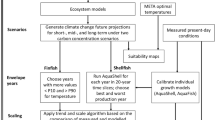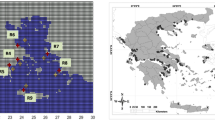Abstract
Aquaculture of channel catfish is an industry with an annual worth of hundreds of millions of dollars. Catfish farms in the United States are, for the most part, confined to the south central region and in California. Their commercial success depends on a climate which produces a sufficiently long growing season and an abundant supply of shallow groundwater. The proximity to markets is also essential. The temperature range for maximum growth of the species is 24°C–29°C with the growth rate rapidly decreasing as the upper lethal temperature — about 35°C — is approached. Growth below 13°C is negligible.
We review the thermal requirements for growth in catfish and examine the role that climate (air temperature and precipitation) plays in limiting the distribution of profitable fish farms. A model is constructed from these relationships which permits the prediction of changes of this distribution resulting from climate warming.
Similar content being viewed by others
References
Allen, K. O.; Strawn, K.: Heat tolerance of channel catfish Ictalurus punctatus. Proceedings of the 21st annual conference of the Southeastern Association. Game and Fish Commission, 399–411, 1968.
Beitinger, T. L.; Fitzpatrick, L. C.: Physiological and ecological correlates of preferred temperature in fish. American Zoologist 19: 319–329 (1979)
Brunson, W. M.; Durorow, M. D. Crosby; Taylor, P. W.: Status of fish farming in Mississippi. For Fish Farmers, Mississippi Cooperative Extension Service. Mississippi State University, 110, 1989.
Carlander, K. D.: Handbook of freshwater fishery biology, Volume two. Iowa State University Press, Ames, Iowa, 1–165, 1977.
Coble, D. W.: Relationship of temperature to total annual growth in adult smallmouth bass. Journal of the Fisheries Research Board of Canada 24: 87–99 (1967)
Douglas, J.: Sharper focus on greenhouse science. Journal of the Electric Power Institute 4–13 (June 1990)
Dupres, H. K.; Huner, J. V.: Third report to the fish farmers. The status of warmwater fish farming and progress in fish farming research. Publication of the US Fish and Wildlife Service. Washington, DC 1984.
Frost, W. E.; Kipling, C.: A study of reproduction, early life, weight-length relationship and growth of pike, Esox lucius L. in Windermere. Journal of Animal Ecology 36: 651–693 (1967)
Hart, J. S.: Geographical variations of some physiological and morphological characters in certain freshwater fish. Univ. Toronto. Biological Series 60, 1–30 (1952)
Johnson, F. G.; Stickney, R. R.: Fisheries. Harvesting life from water. Kendall Hunt Publishing Company, Dubuque, Iowa 1989.
Lagler, K. F.; Bardach, J. E.; Miller, R. R.; Passino, D. R. M.: Ichthyology. 506 pp. John Wiley and Sons, 1977.
McCauley, R. W.; Kilgour, D. M.: Effects of air temperature on growth of largemouth bass in North America. Transaction of the American Fisheries Society 119: 276–281 (1990)
Radforth, I.: Some consideration on the distribution of fishes in Ontario. Contributions of the Royal Ontario Museum (Zoology), Toronto 25: 1–116 (1944)
Schönwiese C. D.: Diekmann, B.: Der Treibhauseffekt. Deutsche Verlagsanstalt, Stuttgart 1987.
Scott, W. B.; Crossman, E. J.: Freshwater Fishes of Canadas Bulletin. 184, 966 pp. Fisheries Research Board of Canada, 1972.
Wernstedt, F. L.: World Climatic Data. 522 pp. Climatic Data Press, Lemont, Pennsylvania 1972.
West, B. W.: Growth, food conversion, food consumption and survival at various temperatures of the channel catfish Ictalurus punctatus (Rafinesque). M. S. thesis, 65 pp. Graduate School, University of Arkansas, 1966.
Author information
Authors and Affiliations
Rights and permissions
About this article
Cite this article
McCauley, R., Beitinger, T. Predicted effects of climate warming on the commercial culture of the channel catfish, Ictalurus punctatus . GeoJournal 28, 61–66 (1992). https://doi.org/10.1007/BF00216407
Issue Date:
DOI: https://doi.org/10.1007/BF00216407




